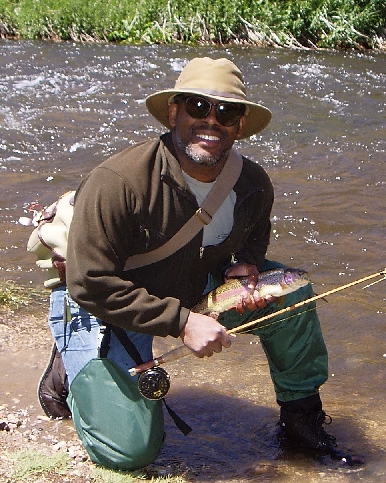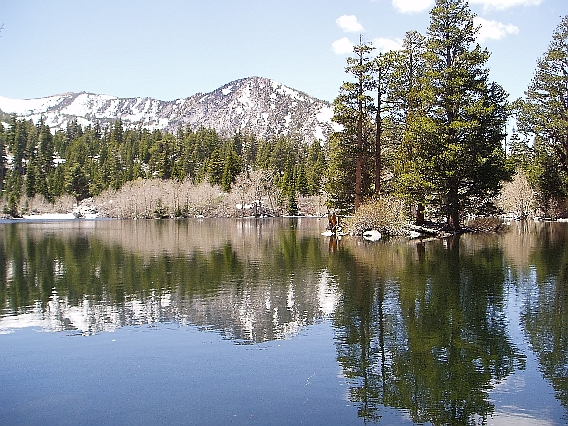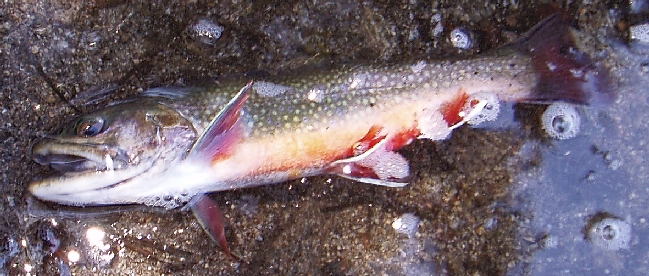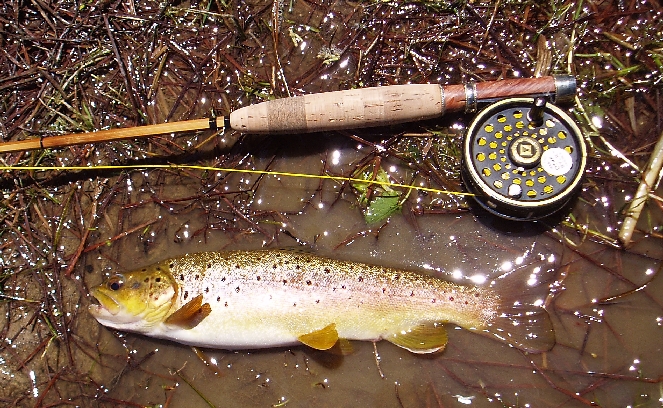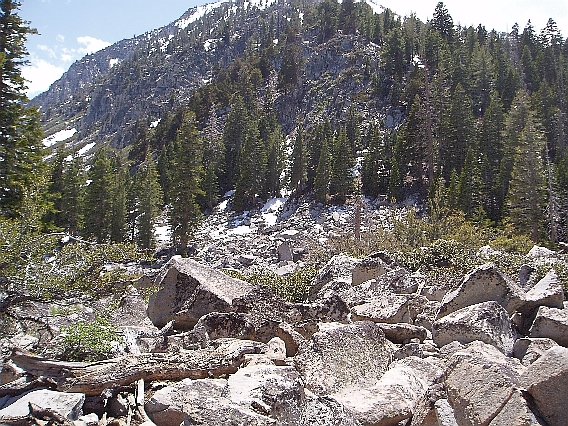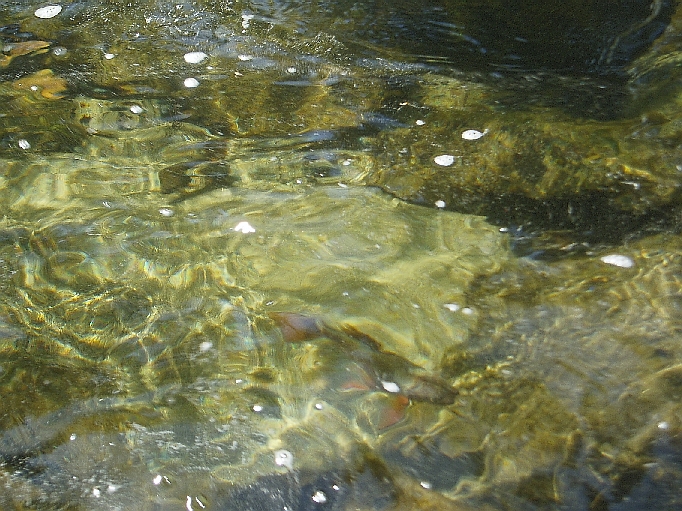|
|
|
|
|
May 29th, 2005 Hot Creek Time: 11:30am - 3:30pm Narrative: If there's one thing you can count on at Hot Creek it's wind. Today was the windiest day that I'd ever spent on Hot Creek, it was absolutely howling. That's the bad, the good? The good is that the wind tends to keep anglers off the water. When I arrived, despite a lot full of cars, I saw only 4 anglers, one was fishing way below stream of me and the others were fishing as a group above stream. That left me plenty of water, plenty of my favorite water to fish. Today was one of those days when I had a plan, a goal for the day's fishing. The goal today was to catch as many fish as possible in order to give my bamboo rod a work out. I'd broken the rod earlier in the year and this was the first time I would get a chance to fish with it since I'd fixed it. Since most high country streams and lakes don't have the quality of fish of Hot Creek, this would probably be my one chance this year to test my rod against some fairly heavy and hot fish. I've fished Hot Creek for several years and have found two ways of dealing with the wind. The first is to short line nymph with a Cortland Deep Nymphing line and the second is to short with a cork indicator. On stream, I initially went for the Deep Nymphing line, only to find out that I had left it in my gear bag. No problem, I'll just use the indicator. A couple of years ago I figured out a pretty good way of getting into fish on Hot Creek when the wind was up and the wind was high. The secret was basically to fish a nymph or pair of nymphs using a cork indicator and an upstream, in air, curve mend or reach mend to place the fly parallel to the indicator in the riffles and below the indicator in deeper water. There's nothing new about the deep water approach, this is standard nymphing. The shallow water idea was new to me, this was my solution to a particular problem. The idea being that in the shallow water, the indicator would move down stream beside the fly. This would make for a sensitive rig without having the indicator float over the fish. When I first used this method on Hot Creek, it worked very well for me and I landed some very good fish. Since then, I've been mostly shortlining Hot Creek without an indicator. I really enjoy shortline nymphing but I'm not proficient enough with it to catch larger fish and with the wind as bad as it was, the indicator was the ticket. I wanted to catch larger fish today and I did, not huge fish, not a lot of fish, but enough fish in the 14 to 16 inch range that I'm confident that my patch job on the rod is going to hold.
May 30th, 2005 Sherwin Lakes Time: 11:00am - 5:00pm Narrative: There's still a lot of snow in the high country. I took a chance that the trail to and more importantly the Sherwin Lakes themselves were free of ice and snow. I gave Vita instructions to meet me in 6hrs and left the trail head not knowing if I'd be able to make it to the lakes, let alone fish them. My guide book, Eastern Sierra Fishing Guide for Day Hikers, lists the trek as a moderate hike of two miles. I'd agree with this but it's interesting to note that I've been on other hikes listed as "moderate" by the author to find that "moderate" was not an accurate description. For those not familiar with this book, it is a must have for the Sierra Fly Fisher. The author, John Barbier, has a similar book the title of which eludes me. Suffice it to say, the Day Hikers book is better. Unfortunately, the "other" book has been reprinted but I understand that the author has no plan to reprint the Day Hiker book and seems to regret writing the books and outing so many lakes. The book itself is quite expensive if purchased from a used book store but I was able to find an ample supply last year at the Saddlebag Lake Resort. The hike was mostly uneventful, I lost the trail about half way up but found it again after a couple of minutes. The folks behind me had the same problem and I tried to get their attention by clapping loudly. I don't know if I succeeded, so I warned a hiker coming down the trail of their predicament. Hopefully they got back on the right track. The Sherwin Lakes consist of 4 lakes and one small pond. The pond is supposed to be barren of fish. I arrived at lake #3 and had planned to fish all the lakes but the terrain changed my plans. The lakes are off the main trail and there do not appear to be any trails leading directly to each individual lake. The terrain is fairly rough and thick and even though I made it to the lake above number #3. It didn't appear to be the large, fertile lake I was expecting.
Lake #3 lake was beautiful but very brushy with a steep shoreline. This made fishing quite a challenge but also quite fun. I made my way around the lake looking for cruising fish. The fish were cruising in pods and spooking them or hooking a single fish meant moving one. The stalking was difficult. The steep terrain meant that you were always right on top of the fish and the brush forced you to get as close to the water as possible. This was a recipe for failure but every so often, I'd get it right and catch a fish. I caught my first and largest fish on my second cast from the easiest spot along the shoreline. It was an area with large trees and lots of shade. There were few of the small brushy trees that line most of the shore and there was a fallen tree a few feet from the bank. When I approached, I could see a pod of fish milling about. They were fairly active, with a few fish taking bugs from the surface. I hid behind the fallen log, making sure to stay in the shadows. I figured I'd only get one cast and after I flubbed it, I was happy to see that I hadn't put all of the fish down. Some of the fish scurried away but it seemed that the fish closest to shore weren't put off. The great thing about the Sir D Favorite rods is that they are great small stream roll casters. That means they can roll cast a mile with a simple squeeze of the hand or flick of the wrist. I made a small flick with my wrist and the largest fish of the bunch confidently rose and turned down with fly in hand or jaw as the case may be. I set the hook and quickly hopped over the tree to land the fish. The fish in this lake were the most color brook trout I've seen in while.
This spot was spoiled and would be for the rest of the day. I made my way up and down the shoreline, attempting to sneak up on fish and scaring them off when I didn't. I didn't perform a traditional cast all day. A raised rod put the fish down right a way and most of my casts were bow and arrow casts or side arm roll casts. One tactic that worked well was to find a rising fish, find an area to cast from 15 or 20 feet down the shoreline, where my rod movement wouldn't scare it, and fire a cast up a long the bank. It was great fun. I made my way along the shoreline to the inlet and then made my way up the inlet to what I hoped was lake #4. The lake I came to was small and looked barren, not the 4 or 5 acre lake that I expected to find. A brief discussion with another fisherman confirmed this and the brush was so dense that I didn't have time to investigate in detail. It's confusing, looking at the guide book map (which is upside down by the way) and the topo map, lake #4 should have been as large as #3.
In retrospect, I think I may have come to a false inlet, leading to a smaller body of water not on the maps. That's too bad because #4 is supposed to have some acrobatic Kamloop rainbows. June 1st, 2005 Hot Creek Time: 6:00pm - 7:30pm Narrative: I hooked into a football today, a real slab of a fish and as football fish are sometimes wont to do, it took off downstream almost immediately. No problem, I was ready for this and slowly began letting the slack line at my feet slide through my hands and past my guides. Unbeknownst to me, a small loop had coiled itself around the handle of my reel and snap! Off went the fish. I've always wondered if when a fish breaks you off with it's fly buried in it's jaw, does the fly drop right out or does it rust out over time? And if it doesn't drop out, what must the fly fisher who next catches the fish think? The fish was easily the largest I've hooked in several years but... that's fishing. Overall, the fishing today seemed to be a bit slower than a few days ago. I had to work much harder than on Sunday and the other anglers I spoke with said they were also having a tough time. I ran into a sight that's becoming all to common on Hot Creek, someone bait fishing. In this case it was two someones. Normally, I make a bee line right to the offender and freely offer up the fishing regs as posted at the trail head. The normal response is "I didn't know", which is a bunch of crap but what can you do, no one likes to be caught doing something they know they shouldn't. Today I was feeling a bit apathetic. Unlike the fellow and his son that I ran into on Sunday fishing plastic worms, these fellows obviously knew better. They arrived just before dark and split pretty quickly. The fellow on Sunday really didn't know how to fish and wanted to show his son a good time. No problem, I searched my fly box and came up with 3 heavily weighted Dark Lords to replace his worm. They're easy to fish and they work on Hot Creek. These fellows however, weren't ignorant. It seems like every time I visit Hot Creek these days, someone is trying to circumvent the regs. I had a short time to fish and I'm frankly a little tired of playing the enforcer. Not only is it getting old but it's a bit dangerous. You never know how folks will react and I frankly didn't feel like getting into a confrontation. The fish were giving me a hard enough time as it was; I figured I'd simply call the DFG tip line later and leave a message. When I climbed back out of the canyon, two other fly fishers asked me if I had chased out the bait fishers. I hadn't, I was actually heading downstream to get a closer look at his gear, when he took off. It seemed pretty obvious he was fishing a great big glob of chanteuse powerbait but I wanted a closer look.. The other fellows hadn't chased off the bait fishers either but they did call the tip line. All three of us gave the "baitists" the evil eye.
June 3rd, 2005 Hot Creek Time: 5:30am - 7:30pm Narrative: I had a tough time of it today. I started out rigging my terminal tackle like Joe Humphreys- two flies, with one tied as a dropper using a blood knot. 2 split shot between the two flies. I'm convinced that this is a good method; after all it works for Mr. Humphreys, but I've never been able to get it to work. Well, tonight wasn't any different. I fished the rig for an hour and didn't detect a single strike. I'm sure they were there but you wouldn't know it by the way I was fishing. I finally switched to my regular set up, dropper off of the bend of the point fly and started to pick up fish. It was tough going though. At dark I caught a nice plump rainbow, which was a nice way to finish the day.
May 30th, 2005 Sherwin Lakes Time: 1:00am - 4:00pm Narrative: The road to the Upper Mammoth Lakes is still closed so I decided to hike back up to the Sherwin Lakes. I wanted to find that fourth lake. Unfortunately, half way up the trail I realized I'd forgotten my reel. I'd also forgotten to bring food but on the list of things to remember, my reel was about 5 places higher than food, just after my rod and before my flies. I'd only been hiking 30 minutes so I could have easily turned around, driven back to the hotel and been back on the trail in 40 minutes. It was 1:30pm and turning back wasn't a likely scenario. If I turned back I'd most likely end up at Hot Creek yet again. I needed the exercise and I figured if nothing else, I could scout the lake. I continued past lake #3 and then cut cross country. I first came to a body of water that I hadn't seen before. Was this the fishless body of water the fisherman referred to on the last trip? If it was, did that mean the water I found was indeed lake #4? It was possible, I'd have to find the lake and then cross the outlet stream to be sure. If lake #4 was the body of water I found the other day, it was supposed to be as big as lake #3. I must have come to some sort of secluded cove. I continued past the stagnant pond and up a small rock pile. From the top of the rock pile I could see the lake I had found the other day. I traversed the perimeter and found myself at what looked like a summer bear den. At the base of a pine tree was a pile of fresh pine needles. The needles were only found on one side of the tree and were flat, like something had been lying on them. In a forest filled with dead leaves, dead tree limbs and dead pine needles, where everything was shades of brown and orange, this green bed stood out. I stood there pondering the needles for a minute. I looked up at the tree and then back down at the needles. It sure looked like a bear den, it was secluded, somewhat protected and close to water. I started clapping my hands as I continued on. My journey went like this....no snakes, jump off a fallen log, clap, clap, clap. No snakes, climb a rock, clap, clap, clap. At the outlet there were 3 fallen logs over the stream that formed a bridge. I hadn't noticed them the last time but I was happy to see them today. The south western side of lake #3 was a boulder field. I knew from the guide book that access to lake 4 required boulder hopping, so I figured I was on the right track. I scurried up the boulder field to a small landing. From there, I could see a small ridge. The type of ridge you find with a lake on the other side. Excited, I quickly made my way to the top of the ridge, only to find another boulder field and another ridge further west. The whole place was very snaky but I hoped that like the mosquitoes, it was too cold for the snakes to be out yet....no snakes, scurry up a rock, clap, clap, clap.
I came to a high point where it was obvious that the only thing south west of lake 3 were boulder fields and more boulder fields. I headed back in the direction of the outlet, I needed to find the western edge of the small lake. I quickly found the western edge of the lake, 200 feet below me and in the distance, I could see a small rapid. A small plunge pool where water entered the lake. It was now clear that this lake was no lake at all but more like a beaver pond, lake #4 was still further south. I took in the scenery, contemplating my best route to the plunge pool and from there up to lake 4 and decided against continuing. From where I was standing, it was going to be tough going to lake 4, either up the boulder field or down to plunge pool and through the brush. Either way, the lake was at least another half mile away and so far my maps had been less than accurate. I wouldn't be able to fish the lake so the best way to find it would probably be to come back with a GPS. I turned around and headed back to the outlet stream. While looking down at the logs, so as to not lose my footing, I noticed two nice pockets of quiet water. I peered into each pocket and could see a brook trout in each. "Well, at least I got to see some fish", I thought to myself. I stood there watching the fish.
The temptation was too great. "Maybe I can tie some tippet to the end of my rod and dap a fly into those pockets." "No, that won't work. The tip top might pull off." "I could tie the tippet to one of the guides. No, that's just as bad" The conversation in my head continued. Then it dawned on me that I had an Orvis mini lead head AND an Airflow intermediate sink leader. I keep both with me for subsurface lake fishing and both have loops on their terminal ends. I looped the lead head through the ring of my slide band reel seat. Then I attached the sink leader to the other end of the lead head and attached seven feet of tippet to the tippet end of the sink leader. I thread the whole thing through the guides of my rod and attached a small bead head pheasant tail nymph. With this set up, I'd have seven feet of tippet hanging from the end of my rod. If I hooked a fish, the stress would be felt down the entire rod. The water was crystal clear. I figured I'd only get one shot at each fish, I'd have to approach from above the fish and didn't think my chances were very good. At lake #3, when I raised my rod the fish were gone. Here I'd have to raise the rod directly above the fish and lower the fly into the water. It was slightly breezy and I figured the fish would spook. I approached the lower pool. The fish which was previously swimming slowly around the small pool had stopped and was now looking straight in my direction. It must have caught site of me as I moved from the shade of the trees to the sun on the bank. I slowly raised my rod slowly over the pool. So far so good. As I lowered the fly in the water, the fish turned and swam purposefully away. It wasn't the startled dash that fish do when spooked but more of a "something doesn't feel right, I'm heading for deeper water" move. I figured the jig was up and tossed my fly into the current; I hoped that the fly would make its way down to the fish, deeper in the stream. On the second cast, a fish took my fly just above and to the outside of the pool. I quickly landed the fish. Unbelievable! I moved to the upper pool. It was empty. I took a good hard look, no fish. I was starting to wonder what went wrong when I noticed TWO fish in the lower pool. The fish I had just released hunkered down deep in the pool. I dapped the fly into the pool again and the second fish hit the fly. After some tricky maneuvering around the shoreline trees, I landed the second fish. The first fish hardly moved during the entire affair.
I'd caught two more fish than I had any right to catch. Unbelievable. With my new found dapping system in hand, I made my way to were I picked up my first fish on Lake 3. A few days ago I could visibly see a pod of fish milling about but today nothing. I figured there might be some fish hiding in the rocks so I dapped and a small brookie rushed the fly. The fish jumped and threw the fly. I dapped again and another fish or the same fish rushed the fly again. I figured three was a good number to end at so I released the fish and headed back to my car. Heading down the trail, I passed several backpackers each asking me how the fishing was. "Pretty good", was my reply, pretty good indeed.
Previous John Muir Wilderness Chronicle Chronicle Index
|

